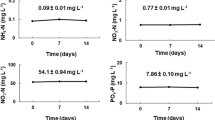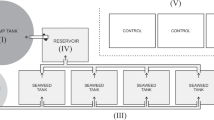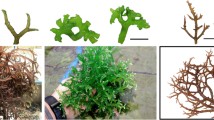Abstract
Along with the search for new species of seaweeds with biofilter capacity, it is also necessary to understand the physiological and biochemical responses of these seaweeds cultivated in different availabilities of nitrate, ammonium, and phosphate. To accomplish this, a laboratory study was performed to evaluate the ability of Hypnea aspera Kützing (Gigartinales, Rhodophyta), to growth under different nitrate, ammonium, and phosphate availabilities and to uptake, assimilate, and remove these nutrients from seawater. Treatments were composed of sterilized seawater enriched with quarter-strength von Stosch’s nutrient solution modified (without any nitrogen and phosphorus compounds). Nitrate or ammonium, together with phosphate, was added in combined N/P ratios of 100:1 and 10:1. Nitrate concentrations varied from 0 to 150 μM, and ammonium concentrations varied from 0 to 70 μM. Growth rates of H. aspera increased with nitrate addition, and the highest value was 4.68 ± 0.76 % day−1 in 150 μM, but the addition of high ammonium concentration (70 μM) in N/P ratio of 10:1 inhibited the growth rates (−3.89 ± 1.03 % day−1). Nitrogen was accumulated as proteins and phycobiliproteins, mainly phycoerythrin, at higher phosphate availability (N/P ratio of 10:1) for nitrate addition (150 μM for proteins and 50, 100, and 150 μM for phycoerythrin), and lower phosphate availability (N/P ratio of 100:1) for ammonium addition (50 and 70 μM for proteins and 50 μM for phycoerythrin). Nitrogen and phosphate were assimilated into thallus in all treatments with nutrient addition. Hypnea aspera showed high removal efficiency (higher than 90 %) of nitrate, nitrite, ammonium, and phosphate present in the seawater. These results suggest that H. aspera could be cultivated in integrated multitrophic aquaculture systems to reduce nutrient loading in eutrophic seawater.










Similar content being viewed by others
References
Ale MT, Mikkelsen JD, Mever AS (2011) Differential growth response of Ulva lactuca to ammonium and nitrate assimilation. J Appl Phycol 23:345–351
Al-Hafedh YS, Alam A, Buschmann AH (2014) Bioremediation potential, growth and biomass yield of the green seaweed, Ulva lactuca in an integrated marine aquaculture system at the Red Sea coast of Saudi Arabia at different stocking densities and effluent flow rates. Rev Aquacult 6:1–11
Andria JR, Vergara JJ, Perez-Llorens JL (2009) Biochemical responses and photosynthetic performance of Gracilaria sp. (Rhodophyta) from Cádiz, Spain, cultured under different inorganic carbon and nitrogen levels. Eur J Phycol 34:497–504
Armstrong FAJ, Tibbits S (1968) Photochemical combustion of organic matter in seawater, for nitrogen, phosphorus, and carbon determination. J Mar Biol Assoc UK 48:143–152
Armstrong FA, Williams PM, Strickland JDH (1966) Photooxidation of organic matter in sea water by ultraviolet radiation, analytical and other applications. Nature 211:463–481
Bird KT, Habig C, DeBush T (1982) Nitrogen allocation and storage patterns in Gracilaria tikvahiae (Rhodophyta). J Phycol 18:344–348
Bradford MM (1976) A rapid and sensitive method for the quantitation of microgram quantities of protein utilizing the principle of protein-dye binding. Anal Biochem 72:248–254
Carneiro MAA (2007) Estudo do crescimento, eficiência de biofiltração e cinética de absorção de nutrientes (N-NH, N-NO e P-PO4 3−) da macroalga Gracilaria cervicornis (Turner) J. Agardh. Masters Thesis, Universidade Federal do Rio Grande do Norte, Natal, p. 75
Chopin T, Wagey BT (1999) Factorial study of the effects of phosphorus and nitrogen enrichments on nutrient and carrageenan content in Chondrus crispus (Rhodophyceae) and on residual nutrient concentration in seawater. Bot Mar 42:23–31
Chopin T, Yarish C, Wilkes R, Belyea E, Lu S, Mathieson A (1999) Develo** Porphyra/salmon integrated aquaculture for bioremediation and diversification of the aquaculture industry. J Appl Phycol 11:463–472
Chopin T, Cooper JA, Reid G, Cross S, Moore C (2012) Open-water integrated multi-trophic aquaculture: environmental biomitigation and economic diversification of fed aquaculture by extractive aquaculture. Aquaculture 4:209–220
Copertino MS, Tormena T, Seeliger U (2009) Biofiltering efficiency, uptake and assimilation rates of Ulva clathrata (Roth) J. Agardh (Clorophyceae) cultivated in shrimp aquaculture waste water. J Appl Phycol 21:31–45
Cordeiro RA, Gomes VM, Carvalho AFU, Melo VMM (2006) Effect of proteins from the red seaweed Hypnea musciformis (Wulfen) Lamouroux on the growth of human pathogen yeasts. Braz Arch Biol Technol 49:915–921
Corey P, Kim JK, Duston J, Garbary DJ, Prithiviraj B (2013) Bioremediation potential of Palmaria palmata and Chondrus crispus (basin head): effect of nitrate and ammonium ratio as nitrogen source on nutrient removal. J Appl Phycol 25:1349–1358
Costa VMF (2006) Utilização da macroalga Ulva lactuca Linnaeus na redução de nutrientes (NH4 +, NO3 − e PO4 −2) provenientes da carcinicultura. Masters Thesis, Universidade Federal do Rio Grande do Norte, Natal, p. 62
Dogyan L, Pickering A, Jun S (2004) Preliminary study on the responses of three marine algae, Ulva pertusa (Chlorophyta), Gelidium amansii (Rhodophyta) and Sargassum enerve (Phaeophyta), to nitrogen source and its availability. J Ocean Univer China 3:75–79
Friedlander M, Dawes CJ (1985) In situ uptake kinetics of ammonium and phosphate and chemical composition of the red seaweed Gracilaria tikvahiae. J Phycol 21:448–453
Grasshoff K, Kremling K, Ehrhardt M (1999) Methods of seawater analysis. Weinheim, Willey-VCH
Haines KC, Wheeler PA (1978) Ammonium and nitrate uptake by the marine macrophytes Hypnea musciformis (Rhodophyta) and Macrocystis pyrifera (Phaeophyta). J Phycol 14:319–324
Hayashi L, Yokoya NS, Ostini S, Pereira RTL, Braga ES, Oliveira EC (2008) Nutrients removed by Kappaphycus alvarezii (Rhodophyta, Solieriaceae) in integrated cultivation with fishes in re-circulating water. Aquaculture 277:185–191
Jeffrey SW, Humphrey GF (1975) New spectrophotometric equations for determining clorophylls a, b, c 1 and c 2 in higher plants, algae and natural phytoplankton. Biochem Physiol Pflanz 167:191–194
Knutsen SH, Murano E, D’Amato M, Toffanin R, Rizzo R, Paoletti S (1995) Modified procedures for extraction and analysis of carrageenan applied to the red alga Hypnea musciformis. J Appl Phycol 7:565–576
Kregting LT, Hurd CL, Pilditch CA, Stevens CL (2008) The relative importance of water motion on nitrogen uptake by the subtidal macroalga Adamsiella chauvinii (Rhodophyta) in winter and summer. J Phycol 44:320–330
Kursar TA, Van Der Meer J, Alberte RS (1983) Light-harvesting system of red alga Gracilaria tikvahiae I. Biochemical analyses of pigment mutations. Plant Physiol 73:353–360
Lapointe BE, Tenore KR (1981) Experimental outdoor studies with Ulva fasciata Delile. I. Interaction of light and nitrogen on nutrient uptake, growth and biochemical composition. J Exp Mar Biol Ecol 53:135–152
Lobban CS, Harrison PJ (2004) Seaweed ecology and physiology. Cambridge University Press, Cambridge, p. 366
Martinéz-Aragón JF, Hernández I, Pérez-Lloréns JL, Vázquez R, Vergara JJ (2002) Biofiltering efficiency in removal of dissolved nutrients by three species of estuarine macroalgae cultivated with sea bass (Dicentrarchus labrax) waste waters 1. Phosphate. J Appl Phycol 14:365–374
Martins AP (2007) Efeitos da disponibilidade de nitrato no metabolismo do nitrogênio em variantes pigmentares de Hypnea musciformis (Wulfen in Jacqu.) J.V. Lamour. (Gigartinales, Rhodophyta). Masters Thesis, Instituto de Botânica da Secretaria do Meio Ambiente, São Paulo, p. 118
Martins AP, Yokoya NS (2010) Intraspecific variations in colour morphs of Hypnea musciformis (Rhodophyta) in relation to nitrogen availability. Hoehnea 37:599–613
Martins AP, Necchi O Jr, Colepicolo P, Yokoya NS (2011) Effects of nitrate and phosphate availabilities on growth, photosynthesis and pigment and protein contents in colour strains of Hypnea musciformis (Wulfen in Jacqu.) J.V. Lamour. (Gigartinales, Rhodophyta). Rev Bras Farmacogn 21:340–348
Menéndez M, Herrera J, Comín FA (2002) Effect of nitrogen and phosphorus supply on growth, chlorophyll content and tissue composition of the macroalga Chaetomorpha linum (O.F. Müll.) Kütz in a Mediterranean coastal lagoon. Sci Mar 66:355–364
Nagano CS, Debray H, Nascimento KS, Pinto VPT, Cavada BS, Saker-Sampaio S, Farias WRL, Sampaio AH, Calvete JJ (2005) HCA and HML isolated from red marine algae Hypnea cervicornis and Hypnea musciformis define a novel lectin family. Protein Sci 14:2167–2176
Nascimento KS, Nagano CS, Nunes EV, Rodrigues RF, Goersh GV, Cavada BS, Calvete JJ, Saker-Sampaio S, Farias WRL, Sampaio AH (2006) Isolation and characterization of a new agglutinin from the red alga Hypnea cervicornis J. Agardh. Biochem Cell Biol 84:49–54
Neushul M (1990) Antiviral carbohydrates from marine red algae. Hydrobiologia 204:99–104
Oliveira EC, Paula EJ, Plastino EM, Petti R (1995) Metodologias para o cultivo no axênico de macroalgas marinas in vitro. In: Alveal K, Ferrario ME, Oliveira EC, Sar E (eds) Manual de Métodos Ficológicos. Universidad de Concepción, Concepcion, pp. 429–455
Ribeiro ALNL, Tesima KE, Souza JMC, Yokoya NS (2013) Effects of nitrogen and phosphorus availabilities on growth, pigment and protein contents in Hypnea cervicornis J. Agardh (Gigartinales, Rhodophyta). J Appl Phycol 25:1151–1157
Ridler N, Wowchuk B, Robinson B, Barrington K, Chopin T, Robinson S, Page F, Reid G, Szemerda M, Sewuster J, Boyne-Travis S (2007) Integrated multi-trophic aquaculture (IMTA): a potential strategic choice for farmers. Aquacult Econom Manag 11:99–110
Rocha NM (2009) Tempo de residência da água em um sistema experimental de aqüicultura integrada com camarões, ostras e macroalgas. Masters Thesis, Universidade Federal do Ceará, Fortaleza, p. 116
Tréguer P, Le Corre P (1975) Manuel d'analyse des sels nutritifs dans l’eau de mer. Lab. Océanogr Chimique Univ Brétagne Occident, Brest
Wu H, Huo Y, Han F, Liu Y, He P (2015) Bioremediation using Gracilaria chouae co-culture with Sparus microcephalus to manage the nitrogen and phosphorus balance in an IMTA system in **angshan Bay, China. Mar Pollut Bull 91:272–279
Yokoya NS (2000) Apical callus formation and plant regeneration controlled by plant growth regulators on axenic culture of the red alga Gracilariopsis tenuifrons (Gracilariales, Rhodophyta). Phycol Res 48:133–142
Yokoya NS, Plastino EM, Artel R (2003) Physiological responses and pigment characterization of two colour strains of the carrageenophyte Hypnea musciformis (Rhodophyta). In: Chapman ARO, Anderson RJ, Vreeland VJ, Davison IR (eds) Proceedings of the 17th International Seaweed Symposium. Oxford University Press, New York, pp. 425–433
Acknowledgments
This research was supported by a scholarship provided by the Fundação de Amparo à Pesquisa do Estado de São Paulo (Fapesp, Brazil, proc. no. 2012/19148-5) to the first author. The authors also acknowledge grants provided by the Conselho Nacional de Desenvolvimento Científico e Tecnológico (CNPq, Brazil, proc. no. 307407/2010-1) and Coordenação de Aperfeiçoamento de Pessoal de Nível Superior (CAPES, Brazil, aux. no. 23038.001431/2014-75). This study is part of the thesis presented by the first author to the Graduate Program in Plant Biodiversity and Environment, Institute of Botany, São Paulo, Brazil.
Author information
Authors and Affiliations
Corresponding author
Rights and permissions
About this article
Cite this article
Ribeiro, A.L.N.L., Chiozzini, V.G., Braga, E.S. et al. Physiological responses and biofilter potential of Hypnea aspera (Rhodophyta, Gigartinales) cultivated in different availabilities of nitrate, ammonium, and phosphate. J Appl Phycol 29, 683–694 (2017). https://doi.org/10.1007/s10811-016-0970-9
Received:
Revised:
Accepted:
Published:
Issue Date:
DOI: https://doi.org/10.1007/s10811-016-0970-9




